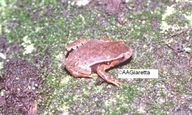|
Paratelmatobius poecilogaster Giaretta & Castanho, 1990
| family: Leptodactylidae subfamily: Paratelmatobiinae genus: Paratelmatobius |
 © 2004 Ariovaldo Giaretta (1 of 1) |
|
|
|
Description Tadpole. eggs were collected at the type locality. The following description is based on a tadpole at Gosner (1960) stage 37: total length 25.8 mm, body length 8.1 mm. Body is ovoid in dorsal view and globular in lateral profile. Nostrils are closer to the eye than to anterior tip of snout. Spiracle is small, sinistral and opens at the posterior half of the body. Cloacal tube is present medially. Labial tooth row formula is 2(2)/3(1). Distribution and Habitat Country distribution from AmphibiaWeb's database: Brazil
Life History, Abundance, Activity, and Special Behaviors
References
Giaretta, A. A., and Castanho, L.M. (1990). ''Nova especie de Paratelmatobius (Amphibia, Anura, Leptodactylidae) da Serra do Mar, Brasil.'' Papéis Avulsos de Zoologia (São Paulo), 37, 133-139. Gosner, K. L. (1960). ''A simplified table for staging anuran embryos and larvae with notes on identification.'' Herpetologica, 16(3), 183-190. Heyer, W. R., Rand, A. S., Cruz, C. A. G., Peixoto, O. L., and Nelson, C. E. (1990). ''Frogs of Boracéia.'' Arquivos de Zoologia Sao Paulo, 31, 231-410. Pombal Jr., J. P. and Haddad, C. F. B. (1999). ''Frogs of the genus Paratelmatobius (Anura: Leptodactylidae) with descriptions of two new species.'' Copeia, 1999(4), 1014-1026. Originally submitted by: Raul E. Diaz (first posted 2004-06-04) Edited by: Tate Tunstall (2008-02-03) Species Account Citation: AmphibiaWeb 2008 Paratelmatobius poecilogaster <https://amphibiaweb.org/species/3380> University of California, Berkeley, CA, USA. Accessed May 14, 2025.
Feedback or comments about this page.
Citation: AmphibiaWeb. 2025. <https://amphibiaweb.org> University of California, Berkeley, CA, USA. Accessed 14 May 2025. AmphibiaWeb's policy on data use. |


 Map of Life
Map of Life